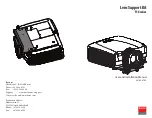
Art. No. DS 4092 TS
movements as well as during large changes. During a fast rotary movement, the size of the
dimming step width is also specified by the rotation angle. The direction of rotation - as in the
other operation concepts for dimming, too - specifies the dimming command (Brighter / Darker).
During a slow operation (notch by notch), the rotary knob transmits dimming commands to the
actuator in a small step width. This step width is configured in the ETS (1.5 %, 3 %, 6 %). The
activated dimmer actuator receives the relative dimming command and controls, for example,
the brightness of the connected lighting system each time a new telegram is transmitted, i.e. by
one notch slightly brighter or slightly darker during each adjustment of the rotary knob.
In contrast to this, a fast operation causes a significant change in brightness by the rotary knob
transmitting greater dimming step widths to the actuator. The size of the step width is
determined by the rotation angle by which the rotary knob is turned within the operation time.
The table below shows the dimming step widths depending on the rotation angle during a fast
rotary knob operation...
Rotation angle (rotation in segment)
relative dimming step width
45° (1/8 rotation)
12.5 %
90° (1/4 rotation)
25 %
180° (1/2 rotation)
50 %
360° (1/1 rotation)
100 %
Dimming step widths depending on the rotation angle during a fast rotary knob operation
The rotation angle is interpreted by segments. Regardless of where the rotary knob operation
starts, relative dimming telegrams are transmitted incrementally to the bus depending on the
segments during a continuous operation (figure 18).
At the start of each control operation, a stop telegram is always transmitted to the bus to be able
to stop the dimming process as well. If the dimmer actuator is in a dimming process at the start
of a control operation, this will be aborted immediately by the stop telegram. The actuator then
executes the new (relative) dimming command of the rotary knob. If the actuator is not in a
dimming process, the stop telegram does not cause any particular reaction. Afterwards, the
dimming telegram causes the dimmer actuator to pass immediately to a new dimming process
according to relative dimming presetting.
i
If the direction of rotation changes without interruption during an operation, no more
telegrams are transmitted continuously until the rotary knob stops. The device evaluates
this operation as a wrong operation.
Page 53 of 143
Software "Rotary sensor with extensions 10FE1x"
Functional description
















































